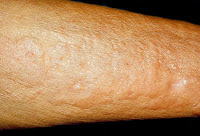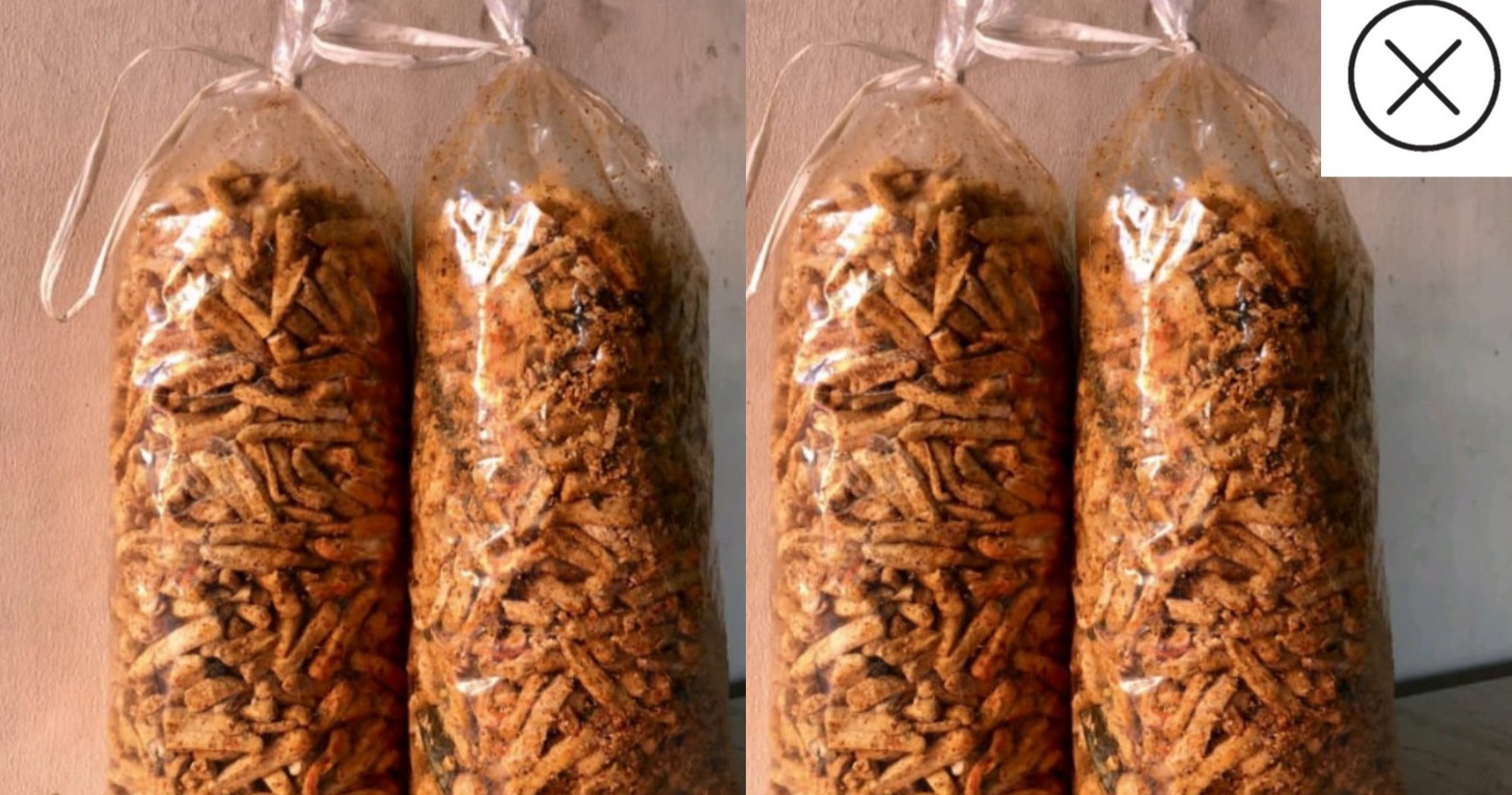Your skin�a window to your health
Butterfly Rash
 A butterfly rash across the face is often the first sign of lupus. But don't jump to conclusions. It could be rosacea, it could be contact dermatitis. Unfortunately, sometimes it is a sign of lupus. Only further tests can tell if it's really lupus.
A butterfly rash across the face is often the first sign of lupus. But don't jump to conclusions. It could be rosacea, it could be contact dermatitis. Unfortunately, sometimes it is a sign of lupus. Only further tests can tell if it's really lupus.
Velvet Plaques
 Velvety plaques in the neck and/or armpit suggest diabetes. This condition -- acanthosis nigricans -- could be benign or be caused by obesity. But it is very often a sign of diabetes. In rare cases acanthosis nigricans occurring in other places, such the hands or lips, may indicate an internal cancer.
Velvety plaques in the neck and/or armpit suggest diabetes. This condition -- acanthosis nigricans -- could be benign or be caused by obesity. But it is very often a sign of diabetes. In rare cases acanthosis nigricans occurring in other places, such the hands or lips, may indicate an internal cancer.
Leg Plaque: Red on Edge, Gold in Center
 Doctors call it necrobiosis lipoidica diabeticorum. As the name suggests, it's a distinctive sign of diabetes, but it is rare. It can first appear as a dull, reddish colored patch but then become shinier with a distinct border. Sometimes the affected skin may crack and become itchy or painful.
Doctors call it necrobiosis lipoidica diabeticorum. As the name suggests, it's a distinctive sign of diabetes, but it is rare. It can first appear as a dull, reddish colored patch but then become shinier with a distinct border. Sometimes the affected skin may crack and become itchy or painful.
Itchy, Violet Bumps on Wrist
 Lichen planus is a rash made up of reddish-purple, flat-topped bumps that may itch like crazy. It usually appears on the wrists or ankles, but may be in the mouth or on the lower back, neck, legs, and genitals. The cause isn't known, but if you have it, you may need to get liver tests. It could be linked to having hepatitis C.
Lichen planus is a rash made up of reddish-purple, flat-topped bumps that may itch like crazy. It usually appears on the wrists or ankles, but may be in the mouth or on the lower back, neck, legs, and genitals. The cause isn't known, but if you have it, you may need to get liver tests. It could be linked to having hepatitis C.
Flesh Colored, Orange-Peel Patches on Back
 Shagreen patches are flesh-colored lesions on the lower back that have the texture of an orange peel. They often occur with other skin signs: red or brown acne-like bumps spreading across the cheeks and nose; and ash-leaf spots of under-pigmented skin, most often on the trunk, that are oval at one end and pointy at the other. These are signs of a rare genetic disease called tuberous sclerosis that causes benign tumors to grow in the brain and other vital organs.
Shagreen patches are flesh-colored lesions on the lower back that have the texture of an orange peel. They often occur with other skin signs: red or brown acne-like bumps spreading across the cheeks and nose; and ash-leaf spots of under-pigmented skin, most often on the trunk, that are oval at one end and pointy at the other. These are signs of a rare genetic disease called tuberous sclerosis that causes benign tumors to grow in the brain and other vital organs.
Tripe Palms
 Tripe palms describes a skin condition in which the skin of the palm becomes thick and velvety-white with pronounced folds in the lines of the hand. The skin resembles boiled tripe. About 90% of cases can be linked to cancer. If only the palms are involved, it may likely be lung cancer. If tripe palms is accompanied by acanthosis nigricans, it's more likely gastric cancer.
Tripe palms describes a skin condition in which the skin of the palm becomes thick and velvety-white with pronounced folds in the lines of the hand. The skin resembles boiled tripe. About 90% of cases can be linked to cancer. If only the palms are involved, it may likely be lung cancer. If tripe palms is accompanied by acanthosis nigricans, it's more likely gastric cancer.
'Wooden' Hands and Feet
 First described in 1997, nephrogenic systemic fibrosis starts as a brown discoloration and indentation of the lower arms and legs. Very soon, the hands and feet become brown and like wood. Sometimes there's also a small yellow spot in the eye. Researchers only recently found that the gadolinium contrast agent used during MRI exams triggers this condition in some patients with kidney disease.
First described in 1997, nephrogenic systemic fibrosis starts as a brown discoloration and indentation of the lower arms and legs. Very soon, the hands and feet become brown and like wood. Sometimes there's also a small yellow spot in the eye. Researchers only recently found that the gadolinium contrast agent used during MRI exams triggers this condition in some patients with kidney disease.
Scaly Rash on Buttocks, Red Tongue
 Fortunately, necrolytic migratory erythema is pretty rare. It's a red, scaly rash, sometimes with small erosions of the skin, more often seen in elderly patients. It tends to start in the fold of the buttocks or palms but can be elsewhere on the body. A bright red, painful tongue is common. The condition usually signals a pancreatic tumor, usually a glucogenoma.
Fortunately, necrolytic migratory erythema is pretty rare. It's a red, scaly rash, sometimes with small erosions of the skin, more often seen in elderly patients. It tends to start in the fold of the buttocks or palms but can be elsewhere on the body. A bright red, painful tongue is common. The condition usually signals a pancreatic tumor, usually a glucogenoma.
Not All Skin Conditions Scary
 Many skin conditions do not indicate that anything else is wrong with you. For example, granuloma annulare is raised, reddish or flesh-colored bumps forming ring patterns that can be found on the hands and feet. They usually go away within two years and don't mean anything is wrong with you. If it is more widespread, then it may last longer.
Many skin conditions do not indicate that anything else is wrong with you. For example, granuloma annulare is raised, reddish or flesh-colored bumps forming ring patterns that can be found on the hands and feet. They usually go away within two years and don't mean anything is wrong with you. If it is more widespread, then it may last longer.
Diagnosing Skin Problems
A variety of skin tests may be performed to diagnose skin allergies, bacterial or fungal skin infections, and other problems affecting the skin. Skin tests are also performed to tell the difference between malignant (cancerous) cells and benign (non-cancerous) growths.
The most common skin tests include:
- Patch testing: Patch tests are used to help diagnose skin allergies. Identified allergens (substances that a person may be allergic to) are applied to the skin with adhesive patches and left for a period of time. The skin is then examined for any reaction.
- Skin biopsy : Skin biopsies are performed to diagnose skin cancer or benign skin disorders. During a skin biopsy, skin is removed (after a local anesthetic is applied) and is taken to a laboratory for analysis. Skin may be removed with a scalpel or a cylindrical punch. Stitches may be used to close the wound.
- Culture: A culture is a test that is done to identify the microorganism (bacteria, fungus, or virus) that is causing an infection. Skin, hair, or nails may be cultured to detect bacteria, fungi, or viruses.
Types of Skin Biopsies
A skin biopsy is a procedure in which a doctor cuts and removes a small sample of skin to have it tested. This sample may help your doctor diagnose diseases such as skin cancer, infection, or other skin disorders.
There are several types of skin biopsy, including:
- Shave biopsy: The doctor shaves a thin layer from the top of a lesion.
- Punch biopsy: The doctor uses an instrument called a punch to remove a circular section through all layers of the lesion.
- Excisional biopsy: The doctor uses a scalpel to take off the entire lesion. This method is used for smaller lesions.
- Incisional biopsy: The doctor uses a scalpel to remove a small sample of a large lesion.
How Is a Skin Biopsy Done?
The doctor will first cleanse the biopsy site, and then numb the skin by using an anesthetic (pain-relieving) injection. The skin is then sampled using one of the above procedures. Shave biopsies do not usually need stitches, while punch, excisional, and incisional biopsies will sometimes be closed with sutures. The procedure is usually done in the doctor's office.
What to Expect After a Skin Biopsy
After the skin biopsy is done you may have some soreness around the biopsied site for a few days. Tylenol is usually sufficient to relieve any discomfort. If you had stitches after the procedure, keep the area as clean and as dry as possible. Your doctor will tell you when the stitches should be removed (usually within one week). If adhesive steri-strips (which look like small pieces of tape) were used to close the incision, do not remove them. They will gradually fall off on their own. If the strips do not fall off on their own, your health care provider will remove them at your follow-up appointment.
You should expect a small scar from the biopsy.
What Is Done With a Skin Biopsy Sample?
The tissue is processed, and a pathologist examines the skin biopsy sample under a microscope to determine if there is any disease. The results usually come back within one to two weeks.
